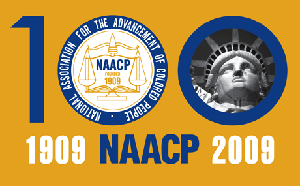HISTORY
History
National Association
On February 12, 1909, the National Association for the Advancement
of Colored People was founded by a multiracial group of activists, who
answered "The Call." They initially called themselves the National
Negro Committee. The founders were Ida Wells-Barnett, W.E.B.
DuBois, Henry Moscowitz, Mary White Ovington, Oswald Garrison
Villard, and William English Walling.
The group was formed partly in response to the horrific practice of
lynching and a 1908 race riot in Springfield, Illinois, that was sparked
by the lynching of two African American men. Many of their formative
meetings were held at the Michigan Street Baptist Church in Buffalo,
New York. The NAACP led a long campaign against lynching and
established itself as a legal advocate with a series of early court
battles.
The organization battled D.W. Griffith's 1915 film, "Birth of a Nation,"
which contained demeaning stereotypes of blacks and glorified the
KKK. In 1930, the association laid the groundwork for reversing the
separate-but-equal doctrine that had governed public facilities since
1896. The campaign ultimately led to the U.S. Supreme Court's
historic school segregation decision in 1954, Brown vs. Board of
Education.
Today, the National NAACP continues its role as a legal advocate for
civil rights issues, but also focuses on economic justice, health care,
education, voter empowerment and the criminal justice system.
Lincoln Branch
...The Lincoln Branch's rich history began in 1918 when Oliver Burckhardt spearheaded its charter. As the organization's first president, Burckhardt recruited influential citizens including the State's Lieutenant Governor and Governor-elect. In 1932, Burckhardt was a key supporter of the formation of the Lincoln Urban League. Local and state officials frequently sought his advice regarding issues affecting the African American community.
The Lincoln Branch did not sit passively by between 1955 and the mid-seventies. Those actively involved in the Civil Rights Movement are names and faces that are vivid in our minds: Dr. Patrick Wells, Rev. G.L. Collins, Lt. Colonel Paul Adams, Mrs. Lenora Letcher, Mrs. Leola Bullock, Rev. Dr. Everett Reynolds, Mr. Hughes and Mrs. Lela Knox Shanks, just to name a few.
Some issues of importance included desegregation of eating places, fair housing, job opportunities, and placement of teachers and administrators in the public schools. The naming of a Lincoln Street "Rosa Parks Way" was a community effort that was led by the Lincoln Branch.
The real story of the nation's most significant civil rights organization lies in the hearts and minds of the people who would not stand still while the rights of some were denied.

Youth and College Division
During the 1935 National Convention, young people challenged the organization to provide youth with a vehicle to address civil rights. The NAACP Board of Directors passed a resolution, formally creating the Youth and College Division in 1936. Under the guidance of Ms. Juanita E. Jackson, the Youth and College Division organized demonstrations against lynching and held group discussions on the inequality of public education.
In 1960, the NAACP proudly saluted the involvement of its youth members in the sit-in demonstrations that began in Greensboro, North Carolina, in an effort to desegregate lunch counters. In 1961, the NAACP Youth and College Division shifted its emphasis from sit-in demonstrations to demands for jobs and equal opportunities for Black workers. In 1963, youth members from around the country responded to the call for a “Jobs and Freedom” march on Washington. The NAACP was a cornerstone among organizations that participated. In 1965, with the passage of the voting Rights Act, NAACP Youth members proved effective in registering over 350,000 voters.
During the period of 1966-1981, the Youth and College Division instituted a vigorous campaign to register minorities between the ages of 18-24; resulting in a 40 percent increase in registered voters in this age category.
Today, there are more than 600 NAACP Youth Councils and College Chapters actively involved in the work of the association. In fact, the NAACP is the only major civil rights organization that includes young people and encourages them to participate fully in its programs-including membership on the National Board of Directors.
Since its inception in 1936, the Youth and College Division has continued to serve as the premier training ground for young civil rights leaders.
With the hard work and dedication of our youth members, the Youth and College Division will carry out its mission of developing an intelligent, assertive and effective youth leadership to ensure the political, educational, financial and social equality of rights for people of color through training, organization and mobilization.
The University of Nebraska College Chapter received its charter in October 2011 with 27 members.
Lincoln Youth Council
The Lincoln Youth Council began in the late 1980s with the encouragement of Lincoln Branch member Mrs. Leola Bullock. Early youth advisers included Mr. Jake Kirkland, Mrs. Patricia Brown Shepard, and Mrs. Ann Stokes. Early youth presidents included Erika Black and Eric Crump. During the early charter years participants were taken to NAACP Regional meetings in Colorado and Kansas City.
Early issues that the youth chapter faced included assurance of educational soundness, understanding why NAACP is important in Lincoln, Nebraska, and the difference youth can make in our community.
One of the early activities was the encouragement of the Martin Luther King March and Rally in Lincoln. The charter of the Lincoln Youth Council has gone through a period of “active” and “inactive”, with at least two periods of inactivation. In October 2011 the charter was reactivated with 26 members.
Lincoln College Chapter
The University of Nebraska College Chapter received its charter in October 2011 with 27 members.
